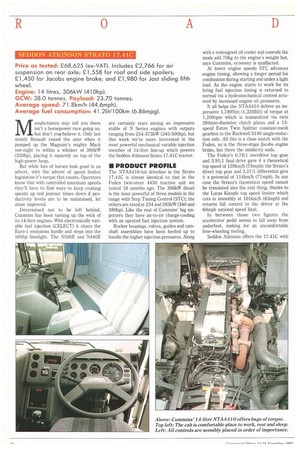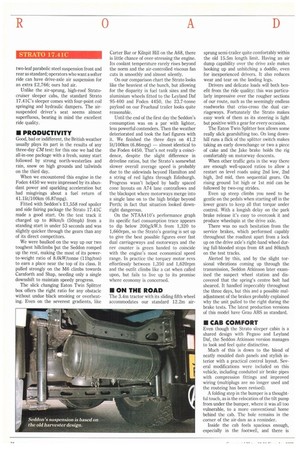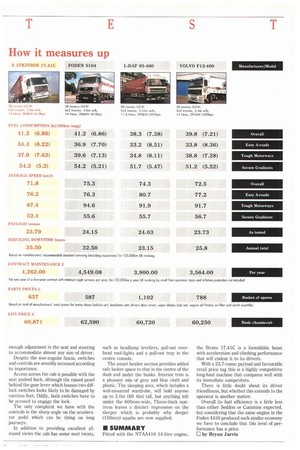SEDDON ATKINSON STRATO 17.41C
Page 34

Page 36

Page 37

If you've noticed an error in this article please click here to report it so we can fix it.
Price as tested: £68,625 (ex-VAT). Includes £2,766 for air suspension on rear axle; £1,558 for roof and side spoilers; £1,450 for Jacobs engine brake; and £1,980 for Jost sliding fifth wheel.
Engine: 14 litres, 306kW (410hp).
GCW: 38.0 tonnes. Payload: 23.70 tonnes.
Average speed: 71.8km/h (44.6mph) Average fuel consumption: 41.2111/100km (6.86mpg).
Manufacturers may tell you there isn't a horsepower race going on, hut don't you-believe it. Only last month Renault raised the ante when it pumped up the Magnum's mighty Mack vee-eight to within a whisker of 395kW (530hp), placing it squarely on top of the high-power heap.
But while lots of horses look good in an advert, with the advent of speed limiter legislation it's torque that counts. Operators know that with controlled maximum speeds they'll have to find ways to keep cruising speeds up and journey times down if productivity levels are to be maintained, let alone improved.
Determined not to be left behind, Cumrnins has been turning up the wick of its 14-litre engines. With electronically variable fuel injection (CELECT) it clears the Euro-1 emissions hurdle and steps into the 500hp limelight. The N500E and N440E are certainly stars among an impressive stable of N Series engines with outputs ranging from 254-373kW (340-500hp), but this week we're more interested in the most powerful mechanical variable injection member of 14-litre line-up which powers the Seddon Atkinson Strato 17.41C tractor.
• PRODUCT PROFILE
The NTAA410-led driveline in the Strato 17.41C is almost identical to that in the Foden twin-steer 4450 tractive unit we tested 16 months ago. The 306kW diesel is the most powerful of three models in the range with Step Timing Control (STC); the others are rated at 254 and 283kW (340 and 380hp). Like the rest of Cummins' big sixpotters they have air-to-air charge-cooling with an uprated fuel injection system.
Rocker housings, valves, guides and camshaft assemblies have been beefed up to handle the higher injection pressures. Along with a redesigned oil cooler and conrods the mods add 70kg to the engine's weight but, says Cummins, economy is unaffacted.
At lower engine speeds STC advances engine timing, allowing a longer period for combustion during starting and under a light load. As the engine starts to work for its living fuel injection timing is returned to normal via a hydromechanical control actuated by increased engine oil pressures.
It all helps the NTAA410 deliver an impressive 1,789Nm (1,3201bft) of torque at 1,200rpm which is transmitted via twin 394mm-diameter clutch plates and a 12speed Eaton Twin Splitter constant-mesh gearbox to the Rockwell S180 single-reduction axle. All this is a close match with the Foden, as is the three-stage Jacobs engine brake, but there the similarity ends.
The Foden's 0.78:1 overdrive top gear and 3.91:1 final drive gave it a theoretical top speed of 120km/h (75mph): the Strato's direct top gear and 121:1 differential give it a potential of 114krn/h (71mph). In any case the Strata's theoretical speed cannot be translated into the real thing, thanks to the Lucas Kienzle top speed limiter which cuts in smoothly at 101km/h (63mpb) and returns full control to the driver at the 60mph national speed limit.
In between those two figures the accelerator pedal seems to fall away from underfoot, making for an uncomfortable free-wheeling feeling.
Seddon Atkinson offers the 17.41C with two-leaf parabolic steel suspension front and rear as standard; operators who want a softer ride can have drive-axle air suspension for an extra £2,766; ours had air.
Unlike the air-sprung, high-roof Stratacruiser sleeper cabs, the standard Strato 17.41C's sleeper comes with four-point coil springing and hydraulic dampers. The airsuspended driver's seat seems almost superfluous, bearing in mind the excellent ride quality.
• PRODUCTIVITY
Good, bad or indifferent, the British weather usually plays its part in the results of any three-day CM test: for this one we had the all-in-one package with a fresh, sunny start followed by strong north-westerlies and rain, snow on high grounds and tailwinds on the third day.
When we encountered this engine in the Foden 4450 we were impressed by its abundant power and sparkling acceleration but had misgivings about a fuel return of 41.1lit/1001trn (6.87mpg).
Fitted with Seddon's £1,558 roof spoiler and side fairing package the Strato 17.41C made a good start. On the test track it charged up to 801cm/h (50mph) from a standing start in under 53 seconds and was slightly quicker through the gears than any of its direct competitors.
We were baulked on the way up our two toughest hilIclimbs but the Seddon romped up the rest, making the most of its powerto-weight ratio of 8.0kW/tonne (11hp/ton) to earn a place near the top of its class. It pulled strongly on the M6 climbs towards Carnforth and Shap, needing only a single downshift to maintain speedy progress.
The slick changing Eaton Twin Splitter box offers the right ratio for any obstacle without undue black smoking or overheating. Even on the severest gradients, like Carter Bar or Kihipit Hill on the A68, there is little chance of over-stressing the engine. Its coolant temperature rarely rises beyond the norm and the air-controlled viscous fan cuts in smoothly and almost silently.
On our comparison chart the Strato looks like the heaviest of the bunch, but allowing for the disparity in fuel tank sizes and the aluminium wheels fitted to the Leyland Daf 95-400 and Foden 4450, the 23.7-tonne payload on our Fruehauf trailer looks quite reasonable.
Until the end of the first day the Seddon's consumption was on a par with lighter, less powerful contenders. Then the weather deteriorated and took the fuel figures with it. We finished the three days on 41.2 lit/100km (6,86mpg) — almost identical to the Foden 4450, That's not really a coincidence, despite the slight difference in driveline ratios, but the Strata's somewhat slower overall average speed is probably due to the sidewinds beyond Hamilton and a string of red lights through Edinburgh. Progress wasn't helped by badly spaced cone layouts on A74 lane contraflows and the blackspot where motorways merge into a single lane on to the high bridge beyond Perth; in fact that situation looked downright dangerous.
On the NTAA410's performance graph its specific fuel consumption trace appears to dip below 200g/kW.h from 1,320 to 1,660rpm, so the Strato's gearing is set up to give the best possible figures over fast dual carriageways and motorways and the rev counter is green banded to coincide with the engine's most economical speed range. In practice the torquey motor revs effortlessly between 1,350 and 1,620rpm and the outfit climbs like a cat when called upon, but fails to live up to its promise where economy is concerned.
• ON THE ROAD
The 3.4m tractor with its sliding fifth wheel accommodates our standard 12.2m air sprung semi-trailer quite comfortably within the old 15.5m length limit. Having an air dump capability over the drive axle makes hooking up and unhitching a doddle, even for inexperienced drivers. It also reduces wear and tear on the landing legs.
Drivers and delicate loads will both benefit from the ride quality: this was particularly impressive over the rougher sections of our route, such as the seemingly endless roadworks that criss-cross the dual carriageways. Fortunately the Strata makes easy work of them as its steering is light but positive with a gear for every occasion.
The Eaton Twin Splitter box allows some really slick gearshifting too. On long downhill runs a flick of the splitter switch makes taking an early downchange or two a piece of cake and the Jake brake holds the rig comfortably on motorway descents.
When other traffic gets in the way there are enough well-spaced ratios to allow a restart on level roads using 2nd low, 2nd high, 3rd mid, then sequential gears. On rising ground 1st high or 1st mid can be followed by two-cog strides.
Even up steep climbs you need to be gentle on the pedals when starting off in the lower gears to keep all that torque under control. With a longish delay on the park brake release it's easy to overcook it and produce wheelspin at the drive axle.
There was no such hesitation from the service brakes, which performed capably throughout the roadtest apart from a lock up on the drive axle's right-hand wheel during full-blooded stops from 48 and 80Iun/h on the test tracks.
Alerted by this, and by the slight torsional vibrations coming up through the transmission, Seddon Atkinson later examined the suspect wheel station and discovered that the spring's centre bolt had sheared. It handled impeccably throughout the three days, but this and a possible maladjustment of the brakes probably explained why the unit pulled to the right during the brake tests. The latest production versions of this model have Grau ABS as standard.
• CAB COMFORT
Even though the Strato sleeper cabin is a shared design with Pegaso and Leyland Daf, the Seddon Atkinson version manages to look and feel quite distinctive.
Much of this is down to the blend of neatly moulded dash panels and stylish interior with a practical control layout. Several modifications were included on this vehicle, including conduited air brake pipes with compression fittings and improved wiring (multiplugs are no longer used and the routeing has been revised).
A folding step in the bumper is a thoughtful touch, as is the relocation of the tilt pump from under the bumper, where it was all too vulnerable, to a more conventional home behind the cab. The hole remains in the corner of the air-dam as a reminder.
Inside the cab feels spacious enough, especially in the footwell, and there is
enough adjustment in the seat and steering to accommodate almost any size of driver.
Despite the non-angular fascia, switches and controls are sensibly accessed according to importance.
Access across the cab is possible with the seat pushed back, although the raised panel behind the gear lever which houses two difflock switches looks likely to be damaged by careless feet. Oddly, both switches have to be pressed to engage the lock.
The only complaint we have with the controls is the sharp angle on the accelerator pedal which can be tiring on long journeys.
In addition to providing excellent allround views the cab has some neat twists,
such as headlamp levellers, pull-out overhead roof-lights and a pull-out tray in the centre console.
The smart header section provides added safe locker space to that in the centre of the dash and under the bunks. Interior trim is a pleasant mix of grey and blue cloth and plastic. The sleeping area, which includes a wall-mounted wardrobe, will hold anyone up to 2.0m (6ft 6in) tall, but anything left under the 600mm-wide, 75mm-thick mattress leaves a distinct impression on the sleeper which is probably why deeper (150mm) squabs are now supplied.
• SUMMARY
Fitted with the NTAA410 14-litre engine,
the Strato 17.41C is a formidable beast with acceleration and climbing performance that will endear it to its drivers.
With a 23.7-tonne payload and favourable retail price tag this is a highly competitive long-haul machine that compares well with its immediate competitors.
There is little doubt about its driver friendliness, but whether this extends to the operator is another matter.
Overall its fuel efficiency is a little less than either Seddon or Cummins expected, but considering that the same engine in the Foden 4450 produced such similar economy we have to conclude that this level of performance has a price.
Eby Bryan Jarvis












































































